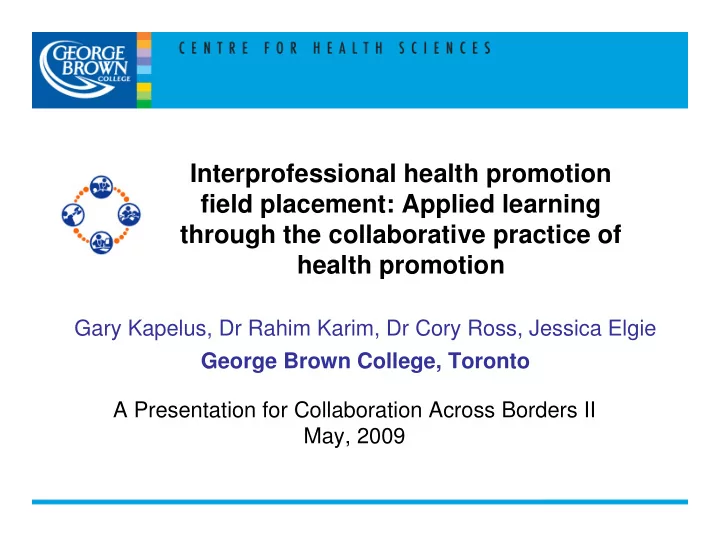

Interprofessional health promotion field placement: Applied learning through the collaborative practice of health promotion Gary Kapelus, Dr Rahim Karim, Dr Cory Ross, Jessica Elgie George Brown College, Toronto A Presentation for Collaboration Across Borders II May, 2009
Overview We will describe the planning, implementation and evaluation of our interprofessional health promotion initiative
About George Brown College • George Brown College is an urban Toronto community college with several downtown campuses. • The Centre for Health Sciences , with over 2,500 full time students, includes 17 programs in the schools of: – Nursing, – Dental Health, – Health and Wellness, and – Health Services Management.
About the Health Promotion Hub Interprofessional Learning Clinic • a ‘controlled applied learning environment’ • on-campus clinic/clinical placement agency providing actual or simulated patients
About the Health Promotion Hub • Health Promotion Hub supports interprofessional student learning, practice and research activities related to the collaborative practice of community-based health promotion . • considered a community agency for purposes of student placements
About the Health Promotion Hub Our program supports the international definition of health promotion (Ottawa Charter, WHO, 1986): “ Health promotion is the process of enabling people to increase control over, and to improve their health”.
Presage Factors • Why we created this program • Fit within our overall IPE strategy • Program objectives • Key planning constraints and logistical issues • Determining preceptor (HP specialist) characteristics (competencies, attitudes, expertise) and how we engaged them • Enabling the learning model to evolve • Planning for continuity and long term sustainability
Presage Factors Why we created this program • Provide a health promotion service to clinic patients • Provide a vehicle for applied interprofessional education
Presage Factors Fit within our overall IPE strategy • IPE experiences include classroom, lab, and clinic-based experiences as well as external placements • Provides an on-campus applied IPE experience which is scaleable
Presage Factors Program objectives • A supervised, hands-on experience planning, implementing and evaluating various health promotion programs, with a variety of target recipients using best practices in health promotion; • An opportunity to experience interprofessional collaboration as members of health promotion teams, and • Opportunities for students to showcase their teamwork and successes
Presage Factors Key planning constraints and logistical issues • Receiving buy-in from programs • Receiving management support and resources • Determining which students and how many would be available to participate and planning for the issues inherent in this student mix • Recruiting and selecting students • Scheduling students across different programs • Rewarding/crediting students for their efforts
Presage Factors Determining preceptor (HP specialist) characteristics • Background and field experience as a health promoter • Ability to organize, supervise and guide a group of students from a variety of professions • An understanding of the principles of IPE
Presage Factors Enabling the learning model to evolve • Identify HP projects based on determinants of health then build on these and expand • Experiment with size and variety of project teams, different student combinations • Incorporated HP101 (free online course) • Added more IPC content and reflection time
Presage Factors Planning for continuity & long term sustainability • Ongoing funding for the HP specialist • Obtaining ongoing commitments from programs to provide students • Linking student learning activity in the Hub to program-specific curriculum requirements • Building organizational capacity: HP brochures, learning materials and presentations, documenting processes • Creating external partnerships
Process Factors First two years: 2007-08; 2008-09 • Which students were involved? • How were they organized? • How were they supported? • What did they actually do?
Process Factors First two years: 2007-08; 2008-09 • Which students were involved? • How were they organized? • How were they supported? • What did they actually do?
Process Factors Medicine Health Dental Hygiene Information Management Activation/ Fitness & Lifestyle Gerontology Management CLCHL 2008-09 Hearing Social Instrument Service Worker Community Services Specialist Prosthetics Architectural Orthotic Technology Nursing
Process Factors • First two years: 2007-08; 2008-09 • Which students were involved? • How were they organized? How were they supported? • • What did they actually do?
Process Factors • First two years: 2007-08; 2008-09 • Which students were involved? • How were they organized? • How were they supported? • What did they actually do?
Process: 2007-08
Product/Outcome Factors What we’ve learned so far: 1. students were able to accomplish a lot as health promoters 2. students were able to work in collaborative teams 3. the appropriateness of the Health Promotion Hub as a vehicle for interprofessional education
Product/Outcome Factors 1. Students were able to accomplish a lot as health promoters • A large portfolio of health promotion initiatives completed over the past two years • Applied theoretical understanding of social determinants of health into real on-the- ground health promotion initiatives, based on best practices in the field of health promotion
Product/Outcome Factors • designed and conducted needs assessments with a variety of populations • developed health promotion programs to meet identified needs • evaluated the impact of their programs • became health advocates (e.g. the water campaign)
Product/Outcomes 2. Students were able to work in collaborative teams • learned about each others’ professions, programs of study, bodies of knowledge, scopes of practice, unique language and perspectives • learned how to work within several interprofessional teams, organized by project • how to plan collaboratively and how to manage interpersonal, interprofessional and logistical challenges when these arose
Product/Outcomes 3. The appropriateness of the Health Promotion Hub as a vehicle for interprofessional education • The positive student experience • Incidental program interaction • Logistical improvements to support better scheduling of teams and completion of projects
Product/Outcomes Funded research project 2008-09: Evaluating health promotion as a vehicle for interprofessional education
Looking Forward Where do we go from here?
Questions We welcome your interest in GBC. Please contact: Dr Rahim Karim Manager, Controlled Applied Learning Environments (416) 415-5000 x 3659 rkarim@georgebrown.ca or Professor Gary Kapelus Professor & Coordinator, Interprofessional Education (416) 415-5000 x 3508 gkapelus@georgebrown.ca
Recommend
More recommend